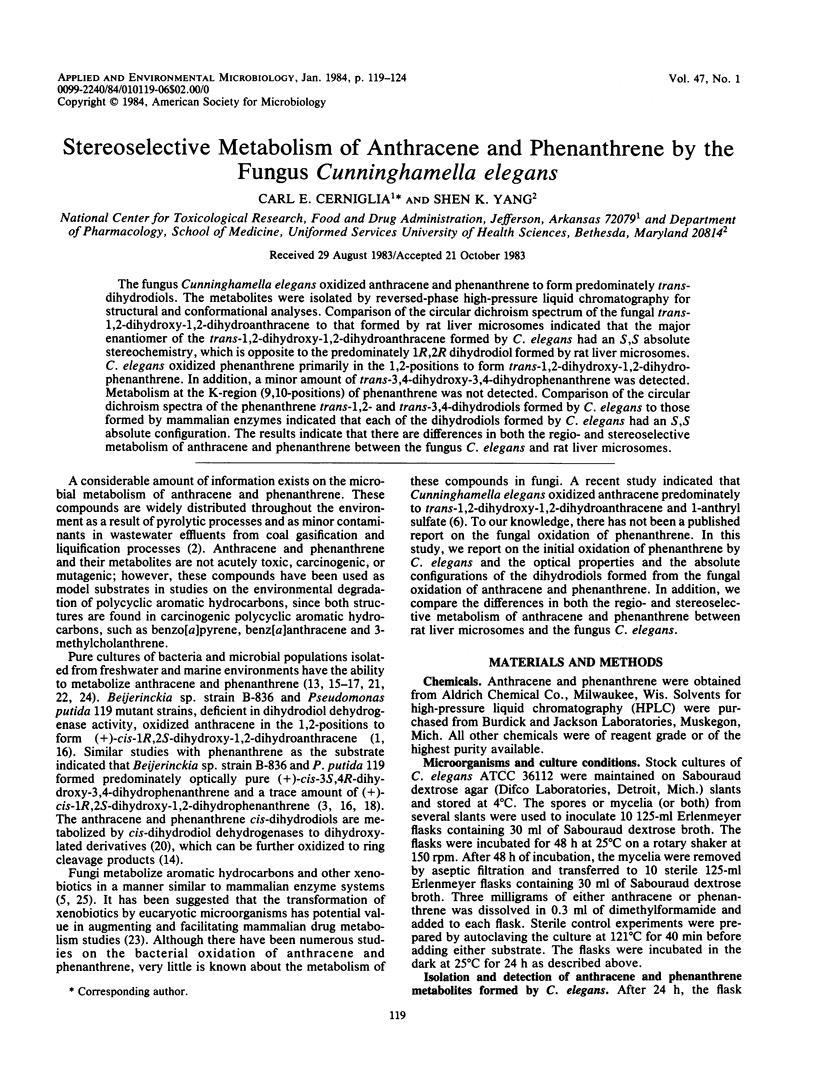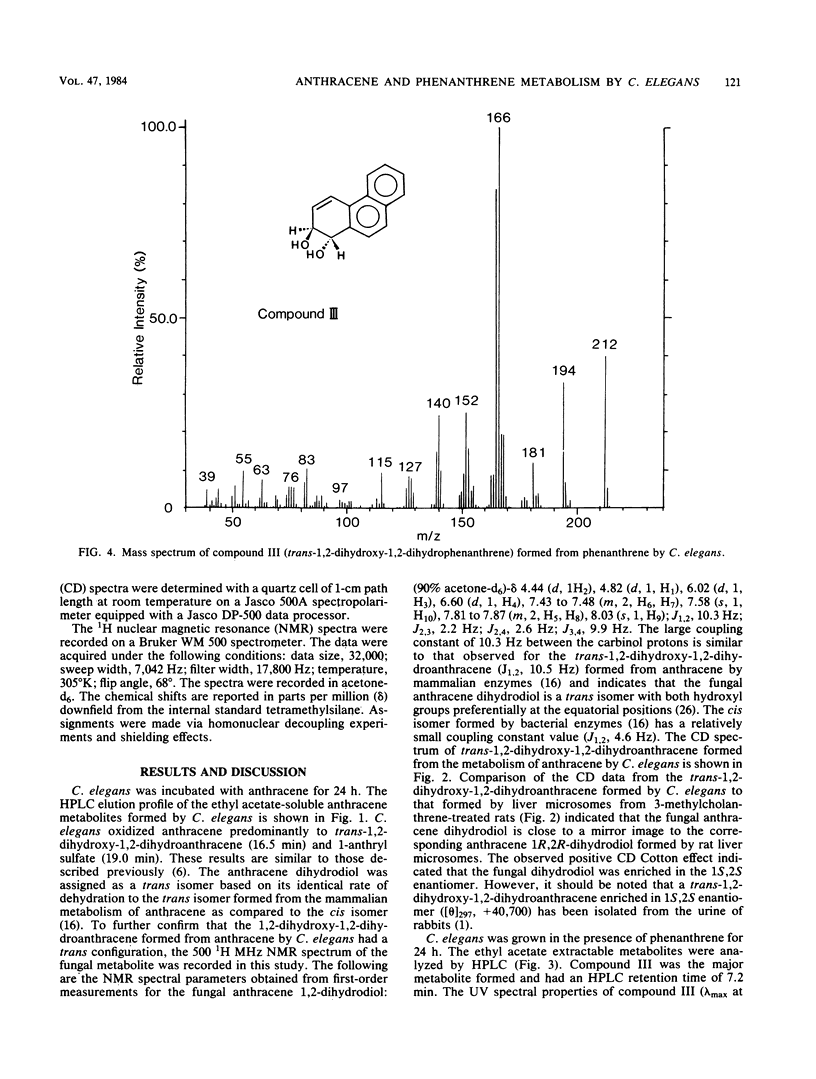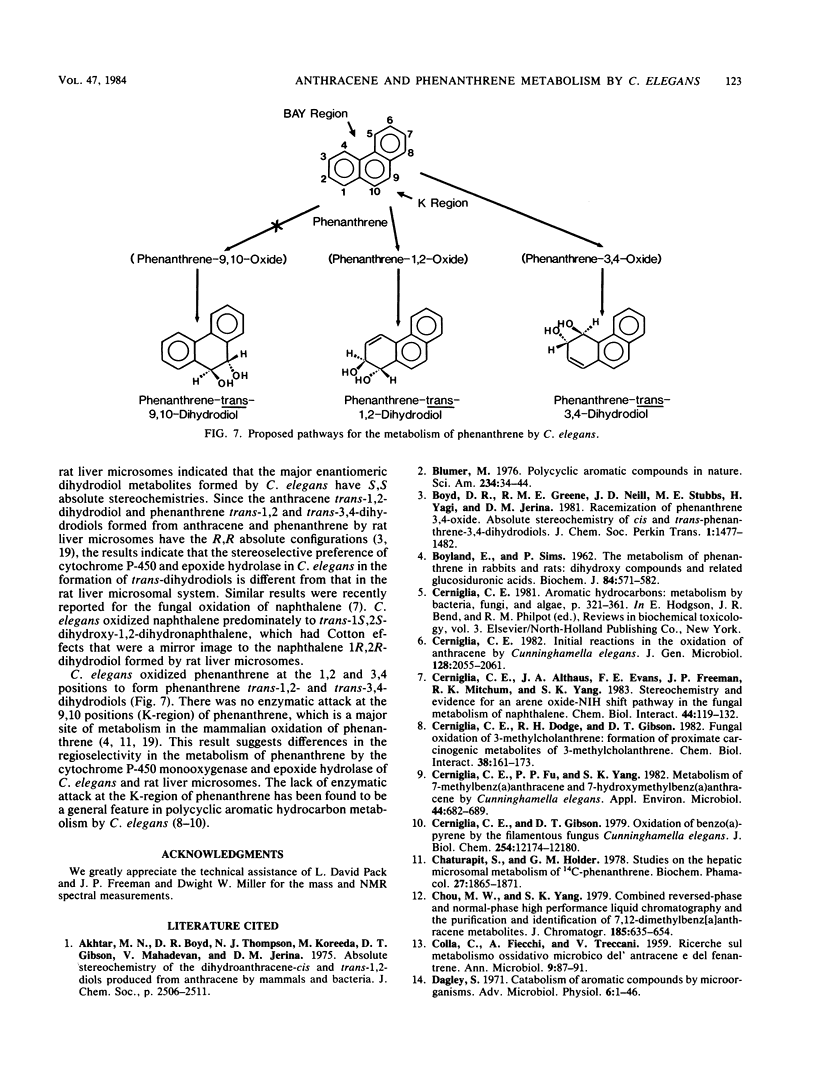Abstract
The fungus Cunninghamella elegans oxidized anthracene and phenanthrene to form predominately trans-dihydrodiols. The metabolites were isolated by reversed-phase high-pressure liquid chromatography for structural and conformational analyses. Comparison of the circular dichroism spectrum of the fungal trans-1,2-dihydroxy-1,2-dihydroanthracene to that formed by rat liver microsomes indicated that the major enantiomer of the trans-1,2-dihydroxy-1,2-dihydroanthracene formed by C. elegans had an S,S absolute stereochemistry, which is opposite to the predominately 1R,2R dihydrodiol formed by rat liver microsomes. C. elegans oxidized phenanthrene primarily in the 1,2-positions to form trans-1,2-dihydroxy-1,2-dihydrophenanthrene. In addition, a minor amount of trans-3,4-dihydroxy-3,4-dihydrophenanthrene was detected. Metabolism at the K-region (9,10-positions) of phenanthrene was not detected. Comparison of the circular dichroism spectra of the phenanthrene trans-1,2- and trans-3,4-dihydrodiols formed by C. elegans to those formed by mammalian enzymes indicated that each of the dihydrodiols formed by C. elegans had an S,S absolute configuration. The results indicate that there are differences in both the regio- and stereoselective metabolism of anthracene and phenanthrene between the fungus C. elegans and rat liver microsomes.
Full text
PDF





Selected References
These references are in PubMed. This may not be the complete list of references from this article.
- Akhtar M. N., Boyd D. R., Thompson N. J., Koreeda M., Gibson D. T., Mahadevan V., Jerina D. M. Absolute sterochemistry of the dihydroanthracene-cis- and -trans-1,2-diols produced from anthracene by mammals and bacteria. J Chem Soc Perkin 1. 1975;(23):2506–2511. [PubMed] [Google Scholar]
- BOYLAND E., SIMS P. Metabolism of polycyclic compounds. 21. The metabolism of phenanthrene in rabbits and rats: dihydrodihydroxy compounds and related glucosiduronic acids. Biochem J. 1962 Sep;84:571–582. doi: 10.1042/bj0840571. [DOI] [PMC free article] [PubMed] [Google Scholar]
- Cerniglia C. E., Althaus J. R., Evans F. E., Freeman J. P., Mitchum R. K., Yang S. K. Stereochemistry and evidence for an arene oxide-NIH shift pathway in the fungal metabolism of naphthalene. Chem Biol Interact. 1983 Apr-May;44(1-2):119–132. doi: 10.1016/0009-2797(83)90134-5. [DOI] [PubMed] [Google Scholar]
- Cerniglia C. E., Dodge R. H., Gibson D. T. Fungal oxidation of 3-methylcholanthrene: formation of proximate carcinogenic metabolites of 3-methylcholanthrene. Chem Biol Interact. 1982 Jan;38(2):161–173. doi: 10.1016/0009-2797(82)90037-0. [DOI] [PubMed] [Google Scholar]
- Cerniglia C. E., Fu P. P., Yang S. K. Metabolism of 7-methylbenz[a]anthracene and 7-hydroxymethylbenz[a]anthracene by Cunninghamella elegans. Appl Environ Microbiol. 1982 Sep;44(3):682–689. doi: 10.1128/aem.44.3.682-689.1982. [DOI] [PMC free article] [PubMed] [Google Scholar]
- Cerniglia C. E., Gibson D. T. Oxidation of benzo[a]pyrene by the filamentous fungus Cunninghamella elegans. J Biol Chem. 1979 Dec 10;254(23):12174–12180. [PubMed] [Google Scholar]
- Chaturapit S., Holder G. M. Studies on the hepatic microsomal metabolism of (14C) phenanthrene. Biochem Pharmacol. 1978;27(14):1865–1871. doi: 10.1016/0006-2952(78)90034-5. [DOI] [PubMed] [Google Scholar]
- Chou M. W., Yang S. K. Combined reversed-phase and normal-phase high-performance liquid chromatography in the purification and identification of 7,12-dimethylbenz[a]anthracene metabolites. J Chromatogr. 1979 Dec 20;185:635–654. doi: 10.1016/s0021-9673(00)85637-x. [DOI] [PubMed] [Google Scholar]
- Dagley S. Catabolism of aromatic compounds by micro-organisms. Adv Microb Physiol. 1971;6(0):1–46. doi: 10.1016/s0065-2911(08)60066-1. [DOI] [PubMed] [Google Scholar]
- EVANS W. C., FERNLEY H. N., GRIFFITHS E. OXIDATIVE METABOLISM OF PHENANTHRENE AND ANTHRACENE BY SOIL PSEUDOMONADS. THE RING-FISSION MECHANISM. Biochem J. 1965 Jun;95:819–831. doi: 10.1042/bj0950819. [DOI] [PMC free article] [PubMed] [Google Scholar]
- Jerina D. M., Selander H., Yagi H., Wells M. C., Davey J. F., Mahadevan V., Gibson D. T. Dihydrodiols from anthracene and phenanthrene. J Am Chem Soc. 1976 Sep 15;98(19):5988–5996. doi: 10.1021/ja00435a035. [DOI] [PubMed] [Google Scholar]
- Nordqvist M., Thakker D. R., Vyas K. P., Yagi H., Levin W., Ryan D. E., Thomas P. E., Conney A. H., Jerina D. M. Metabolism of chrysene and phenanthrene to bay-region diol epoxides by rat liver enzymes. Mol Pharmacol. 1981 Jan;19(1):168–178. [PubMed] [Google Scholar]
- Patel T. R., Gibson D. T. Purification and propeties of (plus)-cis-naphthalene dihydrodiol dehydrogenase of Pseudomonas putida. J Bacteriol. 1974 Sep;119(3):879–888. doi: 10.1128/jb.119.3.879-888.1974. [DOI] [PMC free article] [PubMed] [Google Scholar]
- ROGOFF M. H., WENDER I. 3-Hydroxy-2-naphthoic acid as an intermediate in bacterial dissimilation of anthracene. J Bacteriol. 1957 Jul;74(1):108–109. doi: 10.1128/jb.74.1.108-109.1957. [DOI] [PMC free article] [PubMed] [Google Scholar]
- ROGOFF M. H., WENDER I. The microbiology of coal. I. Bacterial oxidation of phenanthrene. J Bacteriol. 1957 Feb;73(2):264–268. doi: 10.1128/jb.73.2.264-268.1957. [DOI] [PMC free article] [PubMed] [Google Scholar]
- Rosazza J. P., Smith R. V. Microbial models for drug metabolism. Adv Appl Microbiol. 1979;25:169–208. doi: 10.1016/s0065-2164(08)70150-3. [DOI] [PubMed] [Google Scholar]
- Sherrill T. W., Sayler G. S. Phenanthrene biodegradation in freshwater environments. Appl Environ Microbiol. 1980 Jan;39(1):172–178. doi: 10.1128/aem.39.1.172-178.1980. [DOI] [PMC free article] [PubMed] [Google Scholar]
- Smith R. V., Rosazza J. P. Microbial models of mammalian metabolism. Aromatic hydroxylation. Arch Biochem Biophys. 1974 Apr 2;161(2):551–558. doi: 10.1016/0003-9861(74)90338-5. [DOI] [PubMed] [Google Scholar]


